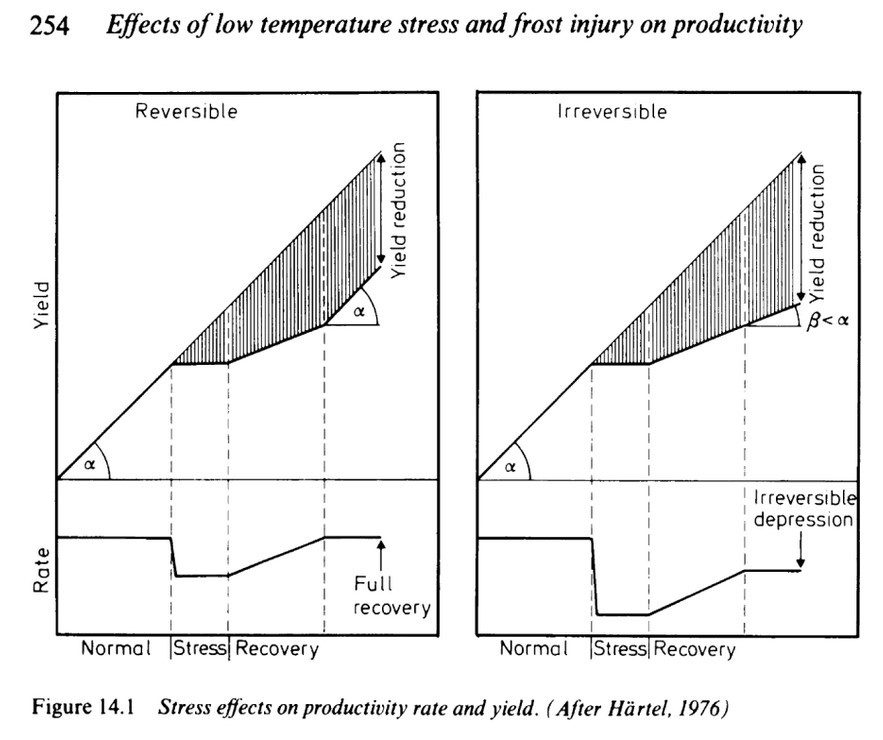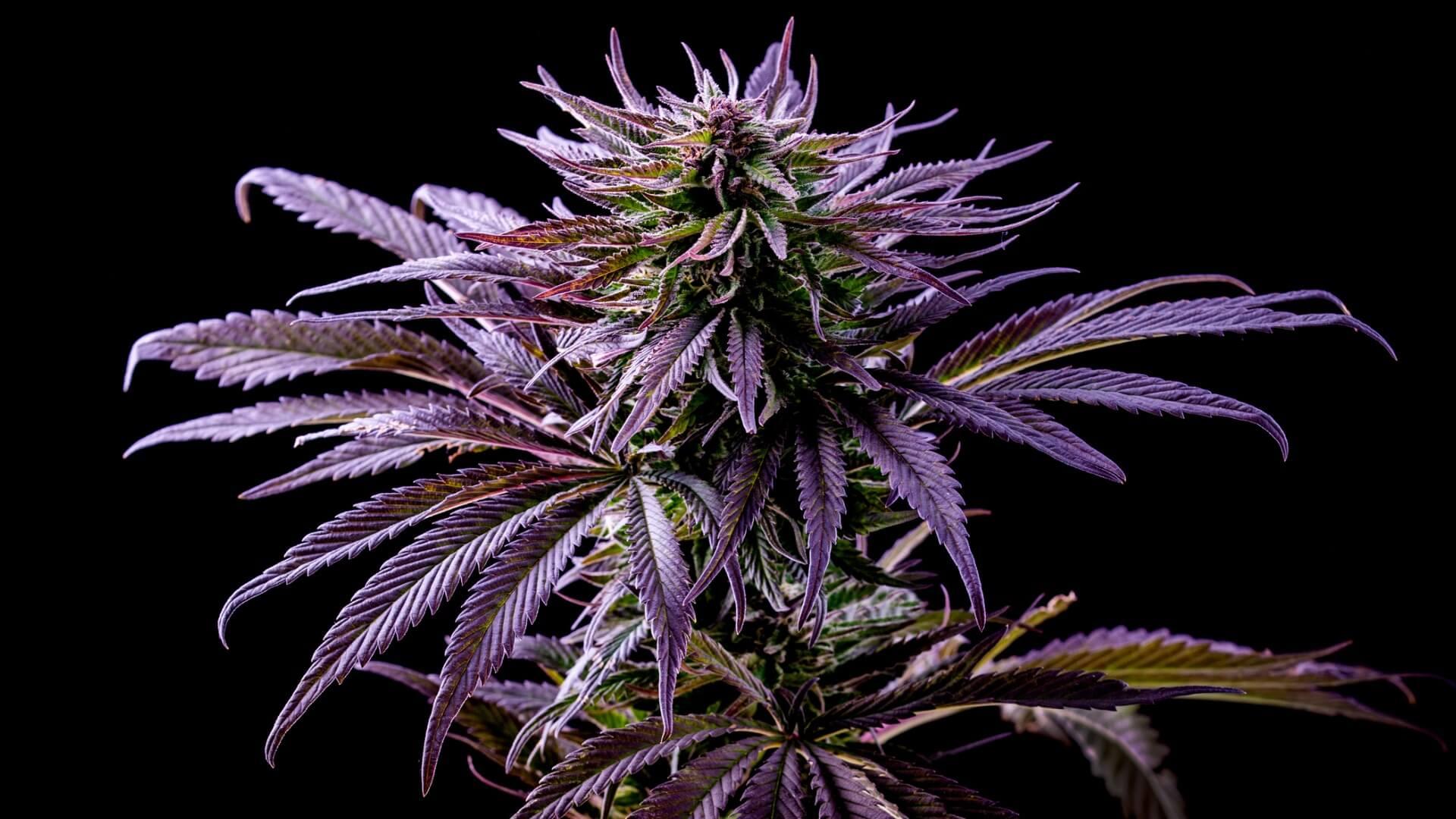Ever wonder if that pretty color might be bad for your bottom line?
This article takes a deep look at purple to find out what it is, what causes it, and how it can affect commercial production.
Note:
This discussion only applies to LEAVES.
Cannabis often produces purple or pink FLOWERS, without low temperature stress. These flower colors are normal.
This flower is one I grew that produced HUGE buds so dark purple they mostly looked black – with bright green leaves at the same time.

Every since I was a little kid staring at a pile of crayons, purple was instantly and always, my favorite color. As an adult, I was immediately smitten by the beauty of cannabis plants with dark purple flowers buried in a crown of bright green leaves.
In my early days as a grower, I was told that I could make my plants turn purple using cooler temperatures, but noticed these plants always grew a bit smaller. Eventually I began to wonder if doing this might have more of a downside than it’s worth.
What’s the deal with this purple stuff.?
The purple color we see in plant leaves is a color pigment called Anthocyanin that can be produced inside plant cells as a defensive reaction to stress.
This dark purple pigment absorbs light at around 530 nm in the PAR wavelengths which is right in the middle of the portion of the spectrum used by plants to do photosynthesis!
Every grower knows you can create purple leaves by lowering the temperature. On the surface this sounds like a simple enough way to create some wildly colorful buds that might even fetch a slightly higher price, but is there really any financial benefit from this?
To answer that question, the first thing you have to understand is that exposing your plants to cold temperature create stress that leaves the plant unable to function properly. If the stress is light, the plant will soon return to normal, but if the stress is past a certain threshold, the damage to plant functions will be at least partly permanent.
Plant stress is defined as a sudden change in environmental conditions that adversely affect the plant growth.
This article will focus on low temperature because this is how cannabis growers stress their plants on purpose, to create the color purple.
From the book, Physiological Processes Limiting Plant Productivity By C. B. Johnson pg 253
Low temperature stress impairs metabolic processes and dry matter production reversibly if moderate: but long-lasting severe stress causes irreversible decrease in productivity, and yield losses.
During a temporary action of non-injurious environmental stress… the plant will recover completely. The yield, however, is shortened because of the lower metabolic activity during stress.
This chart (Figure 14.1) demonstrates the effect of environmental stress on a plant.
On the left is a mild stress event that fails to damage the plant permanently and allows a recovery, but still results in yield loss. The amount of yield loss depends on the duration of the stress.
On the right side of the graphic you see the path of a more severe stress that damages the plant irreversibly and causes a permanent loss of productivity even after the return of favorable conditions. This is what happens when anthocyanin is produced – it causes an irreversible reduction because there is no mechanism for removing anthocyanin.

How many negative things happen when you chill your plants to make them purple.
Mild low temperature stress causes temporary detrimental effects:
- Interruption of growth – especially elongation growth.
- Transient depression of photosynthesis and respiration.
- Stagnation of assimilate translocation.
- Decreased uptake of water and minerals from cold soil.
Extreme low temperature stress can causes permanent detrimental effects:
- Anthocyanin production that lowers photosynthetic efficiency
- Cell death from frozen tissue
Creation of anthocyanin is determined by the degree of sensitivity of the plant and the duration to which it is exposed to low temperatures. The amount of anthocyanin determines the degree of reduction in the amount of light and thus the degree to which it lowers photosynthetic production capacity of the plant.
How does anthocyanin play a role in low temperature stress?
The day after a plant is exposed to low temperatures, the tissues responsible for gathering light for photosynthesis will be malfunctioning. When that malfunctioning photosynthetic machinery is exposed to normal light levels, it can cause permanent damage.
To prevent that damage, the plant needs to protect itself, but plants obviously have no ability to run away and hide in the shade while they recuperate, so instead, they’ve evolved mechanisms to protect themselves without moving, and one of those is to create this dark pigment called anthocyanin that will absorb much of the light so the plant can essentially be shaded from within, while it recovers from the disabling stress of a cold night. It very effectively absorbs much of the light before it has the opportunity to cause any damage.
Anthocyanin provides the same type of protection
as pulling a shade cloth over the greenhouse.
~
Except, once it shows up, you can’t take it off.
Anthocyanins very effectively absorb blue and some green wavelengths which are most damaging to a weakened plant. This gives plants the ability to cut back the visible light, and thereby minimize the negative effects. This process is called low-temperature photoinhibition of photosynthesis, which basically means photosynthesis is being partially shut down.
The phrase, “photoinhibition of photosynthesis” makes it sound like excess light might be the problem, but this reaction is only indirectly caused by the light. The real root of the problem is that stress lowers a plant’s ability to handle even a normal amount of light.
This effect does not affect each cultivar in exactly the same way. Some cultivars are more sensitive and vulnerable to low-temperature stress so they produce anthocyanin at temperatures that hardly seem cold at all, while other cultivars may remain green all the way down to freezing.
When anthocyanin is produced in response to a low-temperature stress, it lowers the plant’s need for complete photoinhibition by absorbing much of the light, which prevents photodamage and allows the plant to continue functioning, although at a much reduced rate.
While this does allow a purple plant to continue functioning under these circumstances, it still results in much of the light being absorbed by the anthocyanin, which reduces the total photosynthetic efficiency of the plant depending on how much purple there is.
Purple blocks photosynthesis
~
Photosynthesis = yield
~
More purple = less plant
Viral infection is another very common cause of purple.
Viruses induce stress that causes the plant to malfunction and thus triggers the same protective responses the plant would use to protect itself from other types of stress. For example, you often see leaf edge rolling which is normally a response to dehydration. Producing anthocyanin in response to a virus is another tool the plant can use in an attempt to protect itself.
Different cultivars respond in very different ways to viral infection. Some lose chlorophyll and become very chlorotic. Others experience irregular patches of leaf tissue that dies completely. Others will have leaves that roll inwards from the sides as if the plant were dehydrated, and some cultivars will turn very, very purple. Some cultivars may develop one or two of these symptoms while others may develop the full collection all at the same time. Some may become so stunted that the flowers are practically non-existent, while some may experience near total leaf death and necrosis while still pumping out huge flowers.
Purple is NOT a natural part of senescence!

The late stage of a crop cycle typically represents the fall season when nutrition in the soil is exhausted, or when the grower begins flushing the substrate to lower nutrition content. This is when Nitrogen and Magnesium become unavailable. These two molecules make up the heart of a Chlorophyll molecule and when they are not present, the green fades out and allows the other pigments to show.
These previously invisible colors are from the carotenes and xanthophylls that produce the yellow, orange, and red pigments. Each of these has some role in photosynthesis but the green normally overpowers these colors when the proper nutrition is available.
Many growers lower temperatures near the end of the crop cycle, which causes purple to show up, but it’s important to know that the purple is NOT a necessary part of senescence.
Anthocyanin is also a pigment much like the others, but it has no role in photosynthesis and instead only serves to absorb light.
If you want to read more about senescence and how it affects cannabis, check out this article.
Are there any other negative effects caused by cold temperature stress?
In this study from Korea, taken from another of my articles titled, “What’s Your Dif,” you can see very strong evidence to show a drop in cannabinoids, flower size, flower yield which means everything valuable about cannabis, begins to drop as plants are exposed to lower temperatures – and these are not even low enough temps for anthocyanin to form. These results come from SLIGHTLY low temperatures. If you go low enough to cause the plant to form anthocyanin there is no evidence to indicate that these drops won’t just get worse and worse as the temps go lower. This study found a very strong “sweet spot” in the day/night temperature ratio of 27:21.


Bottom line:
According to this research, cold-induced purple is reducing your yield by reducing the plant’s ability to absorb light by as much as 50%.
If you want purple buds, the best way to go about it is to purchase a cultivar that produces purple flowers while still maintaining normal green leaves.
References:
Smillie, R., Hetherington, S. Photoabatement by Anthocyanin Shields Photosynthetic Systems from Light Stress. Photosynthetica 36, 451–463 (1999).
Larcher, W. A. L. T. E. R. “Effects of low temperature stress and frost injury on plant productivity.” Physiological processes limiting plant productivity (1981): 253-269.
Giovanni Agati, 2021 Anthocyanins in photoprotection: knowing the actors in play to solve this complex ecophysiological issue.
Effect of diurnal temperature alternations on plant morphology in some greenhouse crops-a mini review doi:10.1016/0304-4238(95)00783-p
